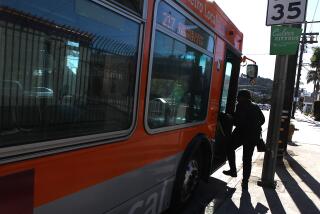The train should stop at Leimert Park
On Thursday, the 13-member Metropolitan Transportation Authority Board will vote on two issues of significant concern to the people of South Los Angeles: whether the new Crenshaw-to-LAX light-rail line will include a station in Leimert Park Village, and whether it will go underground along a congested stretch along the Park Mesa Heights stretch of Crenshaw Boulevard.
The planned rail project will run about 8.5 miles along Crenshaw Boulevard, from the planned Expo Line on the north to the Green Line on the south. Leimert Park is directly in its path, and it would be a huge missed opportunity not to include a stop there. It would also be a mistake not to address in advance the potential traffic nightmare that would ensue if the line isn’t put underground in Park Mesa Heights.
The Park Mesa Heights piece of the motion I wrote is easily understood. Without it, traffic will be unacceptably snarled in an already busy area. The Leimert Park piece takes a little explanation.
Those who have spent time in Leimert Park know that the village is an iconic location in South Los Angeles. It is the Crenshaw community’s Mariachi Plaza, its Ventura Boulevard, its Sunset Strip. It is the heart and soul of the larger neighborhood. In short, Leimert Park is a gem, offering a concentration of cultural institutions found nowhere else in Southern California.
The area was developed by Walter Leimert in 1928 and designed by the landscape architecture firm of John Charles Olmsted and Frederick Law Olmsted Jr., the sons of Frederick Olmstead, who designed New York’s Central Park. The development was an early model of thoughtful urban planning, with its graceful fountain and tree-lined streets. Today, Leimert Park is the center of L.A.’s African American arts scene, famed for its blues and jazz clubs, poetry slams and, more recently, for a successful book fair and an art walk that draws thousands of visitors from throughout the county.
It is inconceivable to many of us who live, work and worship in South Los Angeles that the Crenshaw/LAX line would bypass the heart of the community by not having a station in the village. Rail stops have been shown to reinvigorate the neighborhoods in which they are placed. Just think about Hollywood and Highland, which was a blighted area before redevelopment money and a subway stop transformed it. Leimert Park deserves that kind of boost, and if the decision isn’t made now, it will be too late.
My motion to build the Leimert Park station has drawn criticism from those outside the community. Opponents don’t deny the area’s cultural importance; they simply wonder how it can be paid for and whether it’s necessary.
A station at Leimert Park Village would cost an estimated $120 million. It would be located, depending on where the entrance is built, somewhere between six-tenths and eight-tenths of a mile from the next closest station, which is planned for Martin Luther King Jr. Boulevard near the Crenshaw mall. The MTA says that its policy is that stations should be no closer than one mile apart.
An exception should be made in this case. For one thing, the money is available. An analysis by the MTA staff, completed last week, identified up to $2 billion in funds from low-priority maintenance and system enhancement projects that could be redirected to the Crenshaw/LAX line without affecting any new transit or highway projects.
As for distance, even if it is only six-tenths of a mile from the planned Martin Luther King Jr. Boulevard station, the Leimert Park station wouldn’t be setting a precedent. In fact, contrary to the so-called policy for station placement in the Metro system, 31 out of 73 stations — plus five more under construction — are within six-tenths of a mile of another station.
The truth is that there are multiple precedents set in other communities in which light-rail plans have been altered — sometimes at great expense — in response to community concerns. South Los Angeles certainly has concerns. There are many issues on which neighbors in the area disagree, but on this issue they are united.
I certainly don’t want to thwart other significant transportation projects. This is not a contest, as some maintain, between a train to the airport and a subway to the sea. But funding priorities must be set, and Leimert Park deserves a slice of the transit pie.
For generations, the residents of South L.A. have supported transit projects throughout the county. The community, for example, voted heavily in favor of Measure R, the half-cent sales tax that was levied in the county for transportation projects. Seeking a stop at Leimert Park and requesting that the Park Mesa stretch of the line be underground isn’t asking for an advantage or a favor; it is simply asking for a fair share of available resources. When the Metro board votes Thursday, those who love South Los Angeles will be watching.
Mark Ridley-Thomas is a member of the Los Angeles County Board of Supervisors.
More to Read
A cure for the common opinion
Get thought-provoking perspectives with our weekly newsletter.
You may occasionally receive promotional content from the Los Angeles Times.






